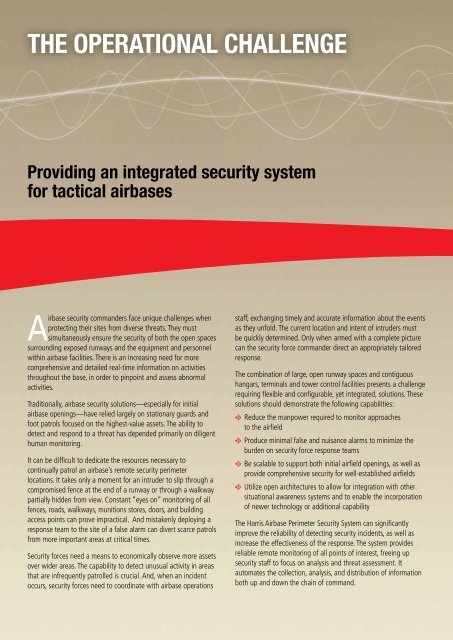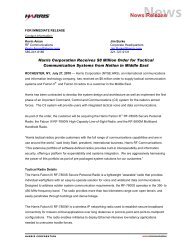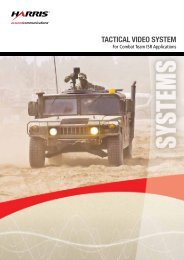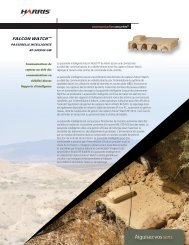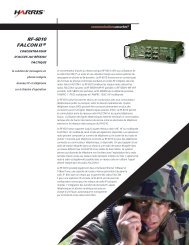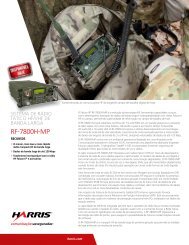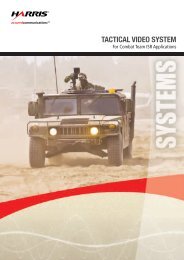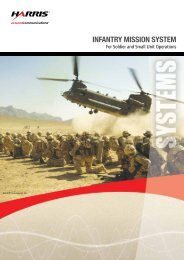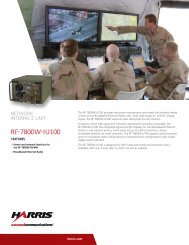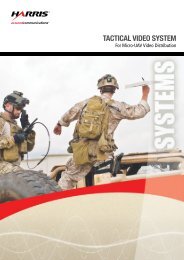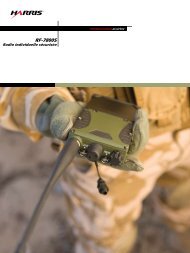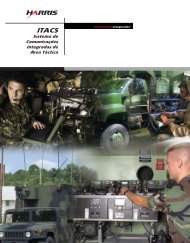HARRIS SECURITY SYSTEM - Harris RF Communications - Harris ...
HARRIS SECURITY SYSTEM - Harris RF Communications - Harris ...
HARRIS SECURITY SYSTEM - Harris RF Communications - Harris ...
You also want an ePaper? Increase the reach of your titles
YUMPU automatically turns print PDFs into web optimized ePapers that Google loves.
THE OPERATIONAL challenge<br />
Providing an integrated security system<br />
for tactical airbases<br />
Airbase security commanders face unique challenges when<br />
protecting their sites from diverse threats. They must<br />
simultaneously ensure the security of both the open spaces<br />
surrounding exposed runways and the equipment and personnel<br />
within airbase facilities. There is an increasing need for more<br />
comprehensive and detailed real-time information on activities<br />
throughout the base, in order to pinpoint and assess abnormal<br />
activities.<br />
Traditionally, airbase security solutions—especially for initial<br />
airbase openings—have relied largely on stationary guards and<br />
foot patrols focused on the highest-value assets. The ability to<br />
detect and respond to a threat has depended primarily on diligent<br />
human monitoring.<br />
It can be difficult to dedicate the resources necessary to<br />
continually patrol an airbase’s remote security perimeter<br />
locations. It takes only a moment for an intruder to slip through a<br />
compromised fence at the end of a runway or through a walkway<br />
partially hidden from view. Constant “eyes on” monitoring of all<br />
fences, roads, walkways, munitions stores, doors, and building<br />
access points can prove impractical. And mistakenly deploying a<br />
response team to the site of a false alarm can divert scarce patrols<br />
from more important areas at critical times.<br />
Security forces need a means to economically observe more assets<br />
over wider areas. The capability to detect unusual activity in areas<br />
that are infrequently patrolled is crucial. And, when an incident<br />
occurs, security forces need to coordinate with airbase operations<br />
staff, exchanging timely and accurate information about the events<br />
as they unfold. The current location and intent of intruders must<br />
be quickly determined. Only when armed with a complete picture<br />
can the security force commander direct an appropriately tailored<br />
response.<br />
The combination of large, open runway spaces and contiguous<br />
hangars, terminals and tower control facilities presents a challenge<br />
requiring flexible and configurable, yet integrated, solutions. These<br />
solutions should demonstrate the following capabilities:<br />
l Reduce the manpower required to monitor approaches<br />
to the airfield<br />
l Produce minimal false and nuisance alarms to minimize the<br />
burden on security force response teams<br />
l Be scalable to support both initial airfield openings, as well as<br />
provide comprehensive security for well-established airfields<br />
l Utilize open architectures to allow for integration with other<br />
situational awareness systems and to enable the incorporation<br />
of newer technology or additional capability<br />
The <strong>Harris</strong> Airbase Perimeter Security System can significantly<br />
improve the reliability of detecting security incidents, as well as<br />
increase the effectiveness of the response. The system provides<br />
reliable remote monitoring of all points of interest, freeing up<br />
security staff to focus on analysis and threat assessment. It<br />
automates the collection, analysis, and distribution of information<br />
both up and down the chain of command.


